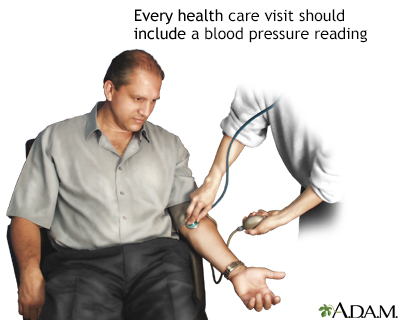| Step 6: Diagnosing high blood pressure |
Every health care visit should include a measurement of your blood pressure. The procedure is quick, easy, and painless.
To measure blood pressure, your doctor or nurse uses an instrument called a "sphygmomanometer," more often referred to as a blood pressure cuff. The cuff is wrapped around your upper arm and inflated to briefly stop the flow of blood in the artery. As the cuff is slowly deflated, the blood begins to flow into the artery again. The doctor or nurse uses a stethoscope to listen to the blood pumping through that artery. When the doctor or nurse hears the first pumping sound, the number on the gauge is the systolic pressure. When the sound stops, the number is the diastolic pressure.
In general, a health care provider needs to take three separate abnormal blood pressure readings, done at least 1 week apart, to make a diagnosis of hypertension.

Guidelines for measuring blood pressure
Blood pressure readings can be inaccurate if the cuff does not fit properly or the patient has just exercised. In addition, some drinks can affect the readings. The following guidelines, set by the National Heart, Lung, and Blood Institute, can help improve the accuracy of your blood pressure measurement:
- Do not smoke or exercise at least 30 minutes before a blood pressure measurement.
- Do not drink caffeinated beverages or alcohol at least 30 minutes before a blood pressure measurement. Go to the bathroom so you have an empty bladder.
- Sit in a chair with your back supported and your arm supported at heart level.
- Sit for at least 5 minutes before your blood pressure is measured.
- For greatest accuracy, your health care provider should take two or more measurements separated by at least 2 minutes. The readings should then be averaged.
White-coat hypertension
The term "white-coat hypertension" refers to when a person's blood pressure rises in the presence of a doctor or health care professional, then returns to normal at home. The phenomenon is fairly uncommon. To evaluate whether a person truly has white-coat hypertension, the doctor may ask a patient to monitor their blood pressure at home or use an ambulatory blood pressure monitor. In many cases, people who believe they just have white-coat hypertension also have high blood pressure at other times away from the doctor's office.
|
Review Date:
6/8/2011 Reviewed By: Steven Kang, MD, Division of Cardiac Pacing and Electrophysiology, East Bay Arrhythmia, Cardiovascular Consultants Medical Group, Oakland, CA. Review provided by VeriMed Healthcare Network. Also reviewed by David Zieve, MD, MHA, Medical Director, A.D.A.M., Inc. |
